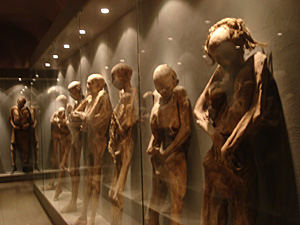
|  |  |  News Around the Republic of Mexico | December 2008 News Around the Republic of Mexico | December 2008  
Macabre Mexican Mummies Eye World Tour
 Robin Emmott - Reuters Robin Emmott - Reuters
go to original


| | The "Mummies of Guanajuato" are naturally mummified bodies interred during a cholera outbreak around Guanajuato, central Mexico in 1833. The bodies were mummified due to the quality of the air and weather in the area. The Monterrey exhibition features 24 mummies and will be held until December 28. |  |
Monterrey, Mexico - A set of macabre mummified corpses, some with their mouths eerily agape or wearing the boots they were buried in, has captivated Mexico and will soon be off to tour the world.

Unlike Egypt's centuries-old swaddled pharaohs, the more than 100 mummies of the city of Guanajuato are relatively youthful bodies that were unexpectedly preserved in the mild, dry conditions of central Mexico between 1865 and 1907.

The corpses have their nails, teeth, genitals and body hair intact, the sealed limestone tombs of Guanajuato's city graveyard having protected them from the microorganisms and maggots that cause bodies to rot.

"The mummies bring us face to face with death," said Felipe Macias, director of the Guanajuato mummies' museum, at a traveling exhibition of 24 of the mummies in the northern city of Monterrey.

A larger showing of around 60 mummies will open in Mexico City in January and after requests from several foreign museums, organizers hope to take them to Chicago, Los Angeles and New York in 2010 and eventually to Europe.

Ghoulishly preserved details of the mummified Mexicans, who died natural deaths or from diseases like smallpox and cholera, give clues to their lives and fascinate visitors.

One 50-year-old woman died while pregnant and the outline of her eight-month-old fetus is visible beneath her coffee-colored, papery skin. Another mummy has a large tumor in its abdomen. The tiniest mummy is a 6-month-old baby.

"It is as if they are telling us to make the most of our lives before we follow them," said Macias.

CELEBRATING DEATH

The mummies were discovered accidentally at the end of the 19th century when cemetery workers opened the tombs of corpses whose families had stopped paying grave taxes on their plots.

More were dug up over the years and for decades they were stacked against a wall in the catacombs of Guanajuato's Santa Paula graveyard where clumsy visitors damaged them with candles, snapped off fingers and let in rodents and insects.

Growing interest led to a museum being opened in the 1970s with the bodies laid on velvet pillows, but a lack of space saw curators send groups of the mummies across Mexico from 2005.

"It is a meticulous process to move and safeguard the mummies. A drop of sweat from a handler could start the decomposing process by letting in bacteria," said Macias.

Some half a million visitors have flocked to the creepy displays since 2005, prompting the plan to send them abroad.

Why Guanajuato has the perfect conditions for mummification is something of a mystery, but experts cite a combination of mild temperatures and a dry climate that allows bodies encased in tombs to dry out before they start decomposing.

Bodies buried in Guanajuato still occasionally mummify. Two children who died in 1984 were added to the collection in late 2005. One, a 5-year-old boy dug up in 1989, is wrapped in a faded white burial gown, his face like a mask without eyes.

Macias said natural mummification could occur within five years of burial, but often humidity and microorganisms manage to get in. "It's not a controlled process," he said.

The exhibition highlights a fascination with mortality that goes back to the ancient Aztecs and Mayas who saw death as an honor and a reprieve from life's pain.

Mexicans still celebrate the Day of the Dead each year at the start of November, flocking to cemeteries to lay marigolds and the favorite foods of the deceased on tombstones.

(Editing by Catherine Bremer and Patricia Reaney) |

 |
|  |



